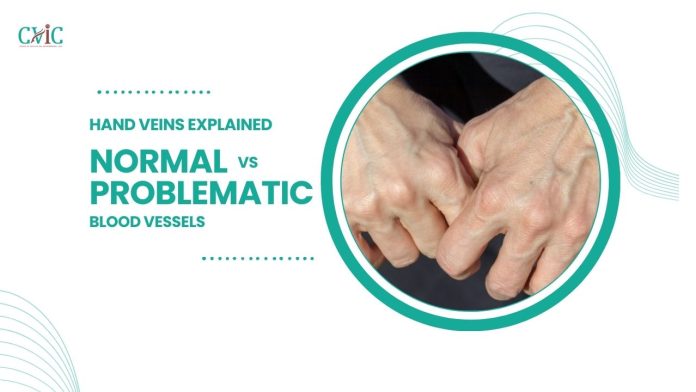Have you ever looked at your hands and noticed the veins standing out—sometimes bluish, sometimes bulging? For some people, these hand veins are completely normal, while in others, they can signal an underlying vascular condition.
But how do you know if your visible veins are just a cosmetic concern—or if they need medical attention?
In this in-depth guide, we’ll explain:
- The anatomy of hand veins
- Why veins appear visible or bulging
- The difference between normal vs. problematic hand veins
- Symptoms that indicate medical issues
- Treatment options for cosmetic and medical concerns
- Advanced hand vein care at CVIC Indore
Understanding the Anatomy of Hand Veins
Your hands contain a network of superficial and deep veins:
- Superficial veins: These lie just under the skin and are more visible.
- Deep veins: These are located deeper in the tissues and are less visible but crucial for blood return.
The main function of these veins is to return deoxygenated blood from the hands back to the heart. Tiny one-way valves inside veins ensure that blood flows upward against gravity.
When skin is thin, veins may naturally appear prominent—especially on the backs of hands.
Normal Hand Veins
For many people, visible hand veins are completely normal. They may become more noticeable in certain situations, such as:
- Aging: Skin thins and fat reduces, making veins more visible.
- Exercise: Physical activity increases blood flow, causing temporary vein bulging.
- Low body fat: Athletes often have naturally visible veins due to less subcutaneous fat.
- Heat exposure: Hot weather or saunas cause veins to dilate.
- Genetics: Some people are born with naturally prominent veins.
👉 These veins are not dangerous and usually don’t require treatment.
Problematic Hand Veins
In some cases, visible hand veins may indicate a medical issue, such as:
- Varicose Veins in Hands
- Though rare, hand veins can become varicose.
- Symptoms: Bulging, twisted veins, discomfort, or heaviness in hands.
- Thrombophlebitis (Vein Inflammation)
- Caused by blood clots or vein irritation.
- Symptoms: Redness, pain, swelling, warmth over the vein.
- Venous Insufficiency
- When vein valves weaken, blood pools instead of flowing upward.
- Symptoms: Swelling, heaviness, and persistent bulging veins.
- Deep Vein Thrombosis (DVT in the Arm/Hand)
- Rare but possible, especially after trauma or catheter placement.
- Symptoms: Sudden swelling, pain, warmth—requires urgent care.
Normal vs. Problematic Hand Veins: A Quick Comparison
| Normal Hand Veins | Problematic Hand Veins |
|---|---|
| Visible due to aging, exercise, or thin skin | Caused by varicose veins, clots, or vein disease |
| Temporary bulging (post-exercise, hot weather) | Persistent swelling or pain |
| Soft, painless, no skin changes | Painful, hard, red, or discolored |
| Cosmetic concern only | May require medical treatment |
When to See a Doctor
You should consult a vein specialist if you notice:
- Persistent swelling or heaviness in the hand
- Pain, redness, or warmth over veins
- Sudden bulging of one hand vein without reason
- Skin changes such as ulcers or dark patches
- Family history of vein disease or clotting issues
Treatment Options for Hand Veins
Depending on whether your concern is cosmetic or medical, treatment options vary:
1. Cosmetic Treatments for Hand Veins
- Dermal Fillers: Adds volume under the skin, reducing vein visibility.
- Sclerotherapy: Injection of a solution that closes unwanted veins.
- Laser Therapy: Non-invasive treatment to fade small visible veins.
- VenaSeal Closure: Uses medical adhesive to seal problematic veins.
2. Medical Treatments for Problematic Veins
- Blood Thinners: For clot-related conditions.
- Compression Therapy: Improves circulation.
- Endovenous Ablation: Uses heat or radiofrequency to close diseased veins.
- Minimally Invasive Thrombectomy: Removal of blood clots using catheters.
Preventing Vein Problems in Hands
While you can’t avoid genetics or aging, you can maintain healthy veins by:
- Staying active with regular exercise.
- Avoiding smoking.
- Keeping hydrated.
- Wearing sunscreen to slow skin thinning.
- Eating a balanced, vein-friendly diet.
Hand Vein Treatments at CVIC Indore
At the Center of Vascular and Interventional Care (CVIC), Indore, we provide specialized care for both cosmetic and medical vein conditions.
Why CVIC for Hand Vein Care?
✅ Expert team of interventional radiologists
✅ Ultrasound-guided precision treatments
✅ Options for sclerotherapy, laser therapy, VenaSeal, and fillers
✅ Minimally invasive, same-day procedures
✅ Personalized treatment plans for each patient
📍 Location: CVIC – Center of Vascular and Interventional Care, Indore
📞 Contact: 91-8103727728
🌐 Contact form: https://cvicvascular.com/contact/
FAQs About Hand Veins
Q1. Are visible hand veins a sign of health problems?
👉 Not always. In many cases, they are normal due to thin skin or exercise.
Q2. Can hand veins be removed permanently?
👉 Yes, with treatments like sclerotherapy, VenaSeal, or laser therapy at CVIC.
Q3. Do hand veins return after treatment?
👉 Treated veins do not come back, but new veins may become visible over time.
Q4. Is treatment painful?
👉 Most procedures at CVIC are quick, minimally invasive, and cause little discomfort.
Q5. Should I worry if my hand veins suddenly bulge?
👉 If it happens without reason and is accompanied by pain/swelling, see a doctor immediately.
Conclusion
Visible hand veins can be completely normal—especially with aging, exercise, or genetics. But in some cases, they may signal underlying vein disease that requires medical care.
The good news is, whether your concern is cosmetic or medical, advanced treatments like fillers, sclerotherapy, laser therapy, and VenaSeal can restore both health and confidence.
👉 For expert diagnosis and world-class care, consult the specialists at CVIC Indore—the leading center for vascular and vein treatments in Central India.




